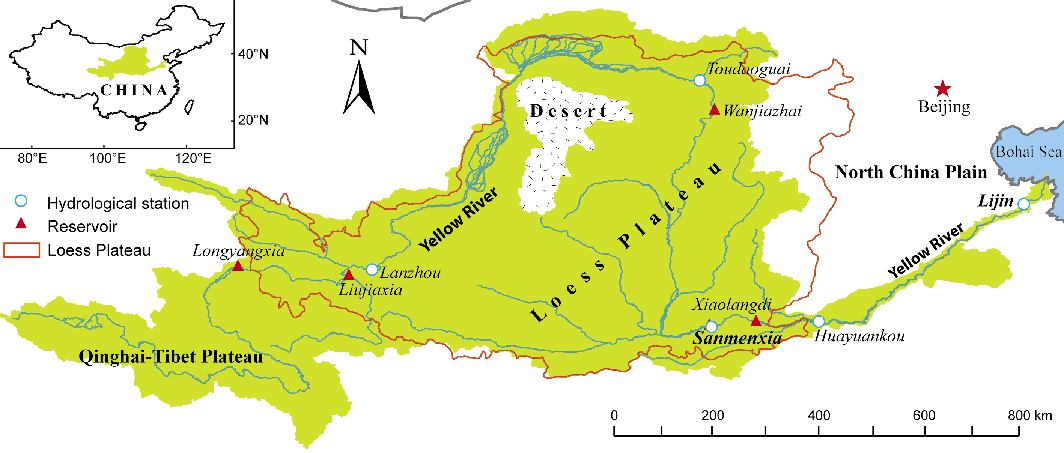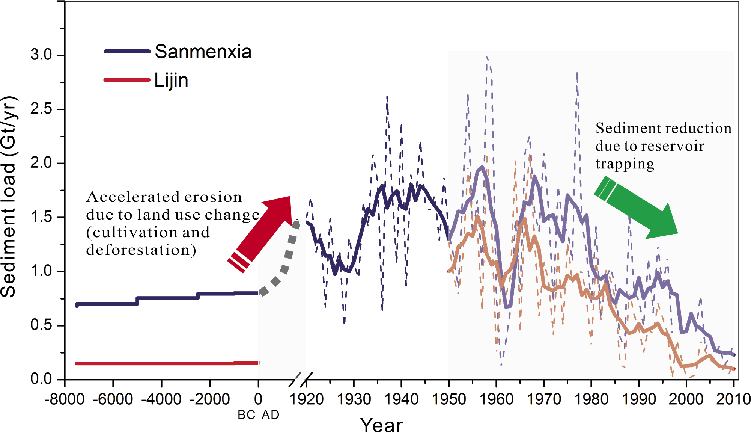- Home
- Publications
- PAGES Magazine
- Sediment Load and Carbon Burial In The Yellow River During The Holocene
Sediment load and carbon burial in the Yellow River during the Holocene
Ran L & Lu XX
Past Global Changes Magazine
22(1)
34-35
2014
Lishan Ran and Xixi Lu
Sediment load in the Yellow River has increased dramatically during the Holocene in response to human land use. However, dams and reservoirs have reverted that trend, and sediment load has now reached levels even below those of the early Holocene.
Fluvial sediment transport by the world’s rivers has generally been affected by humans throughout the Holocene (Sluyter 1997; Hoffmann et al. 2010). However, the exact effect of human activities was specific for each river due to the differences in landform, climate, and the cultural history. Different types of human activities can result in distinctively different sediment load processes.
Extensive agricultural practices and deforestation accelerate soil erosion and thus considerably increase riverine sediment load, while large-scale soil conservation measures and dam construction can reduce it. Being the cradle of the Chinese civilization, the Yellow River basin has been strongly influenced by intensive human activity during the Holocene. Thanks to the long and continuous historical records available, the Yellow River is well suited for studying the long-term human impact on rivers and sedimentary basins.
 |
|
Figure 1: Location of the Yellow River basin with its middle reaches covered by the Loess Plateau that serves as the major sediment source. |
Located in northern China (Fig. 1), the Yellow River basin is nowadays characterized by semiarid to arid climate and poor vegetation cover. The Yellow River basin is in large part surrounded by the highly erodible loess deposits of the Loess Plateau. Accordingly, it is well known for its strong soil erosion, which ranks amongst the highest in the world. During the early and middle Holocene, the sediment load of the Yellow River was estimated to be approximately 0.7-0.8 Gt/yr at the location of the Sanmenxia hydrological station (Shi et al. 2002; Fig. 2). This number includes accumulation on the lower alluvial plains and the delta. High sediment load during this period may have resulted from poor vegetation cover and/or an increasingly arid climate on the Loess Plateau following glacial retreat (Milliman et al. 1987). Due to intensive human activities, in particular agricultural cultivation and deforestation on the Loess Plateau (Ren and Zhu 1994; Liu et al. 2002; Saito et al. 2001; Wang et al. 2007), the sediment load increased strongly to 1.6-1.8 Gt/yr ca. 1000 years ago. Over the past 1000 years the Yellow River sediment load passing Sanmenxia remained overall stable at a high level of 1.7-1.8 Gt/yr, resulting in increasingly serious channel sedimentation in the lower Yellow River and progressive delta growth. The total sediment deposition downstream of Sanmenxia during the Holocene has been estimated, through radiocarbon dating, to be 8000 Gt, of which 5280 Gt was deposited on the North China Plain and 2720 Gt settled on the seafloor (Shi et al. 2002). As a result, the delta area was growing at a mean rate of 20-25 km2/yr (Wang et al. 2007).
However, during the past few decades the sediment load recorded at Sanmenxia has decreased markedly, particularly since the 1950s with the onset of extensive human activities (Fig. 2). Compared with the period of 1950-1959, the decadal mean sediment load in 2000-2010 has decreased by 80%, reaching a load even lower than the pristine level of the early Holocene. It is evident that massive dam construction and vegetation restoration within the basin are the primary reasons for this reduction. For example, artificial dams and reservoirs have trapped 40.3 Gt of sediment during the period 1950-2010 (Ran et al. 2013), corresponding to an annual mean of 0.67 Gt/yr. In comparison, the mean sediment load at Sanmenxia station over that same period was about 1.1 Gt/yr. Human activities have been estimated to contribute 70-80% to the sediment reduction, while the remaining 20-30% are related to a trend of decreasing precipitation (Lu et al. 2003; Wang et al. 2007). As a result, the present sediment budgets appear to be reverting to levels comparable to those before human impact due to the combined effects of damming and climate change.
Carbon budget implications
Variations in sediment dynamics over time are critical for budgeting the biogeochemical cycling of carbon and nutrients (e.g. Battin et al. 2009; Hoffmann et al. 2010). Despite the lack of direct evidence due to the absence of historical records, it is likely that the amount of particulate organic carbon (POC) transported in the Yellow River has varied significantly during the Holocene. Most of the Yellow River sediment (~90%) originates from the Loess Plateau where eroded top soils have a uniformly low organic carbon content. It can therefore be expected that riverine POC fluxes was dominantly controlled by temporal variations in the fluxes of total sediment. If the soil POC content was 0.5-1% as suggested by new unpublished data, then approximately 40-80 Gt of POC have been buried due to sedimentation during the Holocene.
Human activities over the past six decades have also resulted in considerable carbon burial, for example through sediment trapping. Assuming the same POC content as above suggests that 0.2-0.4 Gt of POC have been trapped by dams during 1950-2010. The sediments accumulated in reservoirs should sequester POC relatively effectively because the anaerobic waters in the reservoirs prevent the buried carbon from oxidation, limiting decomposition to anaerobic processes such as methanogenesis. More research is needed to quantify mineralization rates and residence times of POC in reservoirs. As POC accounts for more than 90% of total organic carbon in the Yellow River (Cauwet and Mackenzie 1993), the reduced POC fluxes, together with decreased sediment loads, have resulted in far-reaching physical and biogeochemical responses in the estuary and in marine ecosystems within the discharge plume. Continuous retreat of the Yellow River delta in recent decades has been observed due to the reduced sediment supply, and the decreased riverine supply of carbon and nutrients has significantly influenced its ecological integrity (Xu et al. 2004; Li et al. 2009; Syvitski et al. 2005). For example, reduced sediment and nutrient discharge and intrusion of salt water into the delta wetlands have led to substantial salinization, resulting in rapid degradation of bird habitats (Cui et al. 2009).
Future perspectives
Human activities are now reducing the sediment load in the Yellow River basin at an unprecedented pace. In addition to the numerous dams under construction and in the planning, large-scale soil conservation programs, such as the Grain-for-Green Project, are being carried out in the drainage basin, in particular the Loess Plateau, to control soil erosion and mitigate land degradation. These activities, combined with decreasing amounts of rainfall, suggest that the sediment load and associated carbon transported by the Yellow River will further decrease in future. Furthermore, the accelerating human activity in the region is likely to increase the role of anthropogenic over natural factors on sediment and carbon dynamics even more over the next decades.
With respect to greatly reduced sediment loads, attempts have been made to explore the geomorphological, ecological, and other environmental impacts (Wang et al. 2007); however, in comparison, less attention has been devoted to studying the implications of carbon burial of sediments within the basin and of the decreased carbon fluxes reaching the ocean. As one of the rivers in the world with the highest sediment flux (Milliman et al. 1987), the associated carbon amount in the Yellow River is considerable. The carbon and nutrient dynamics of the basin are likely to undergo further substantial changes in the near future. The details of the sediment dynamics and the biogeochemical consequences are not well understood. Consequently, effective mitigation strategies are difficult to develop. Analyzing the river’s storage and transport history over the Holocene and the associated environmental impacts provides an opportunity to improve our quantitative understanding of fluvial systems and associated ecosystems.
The Yellow River’s well-defined thousand-year sediment yield increase, resulting from land use change, and the subsequent sudden decrease after 1950 AD, largely due to reservoir construction, is exceptional, and thus provides an almost ideal “experimental” case study for research under the Soil & Sediment and Carbon Themes of PAGES.
acknowledgements
This work was supported by the Ministry of Education, Singapore (MOE2011-T2-1-101).
affiliation
Department of Geography, National University of Singapore, Singapore
contact
Lishan Ran: georl nus.edu.sg
nus.edu.sg
references
Battin TJ et al. (2009) Nat Geosci 2: 598-600
Hoffmann T et al. (2010) Global Planet Change 72: 87-98
Lu XX et al. (2013) Int J Sediment Res 28: 1-14

